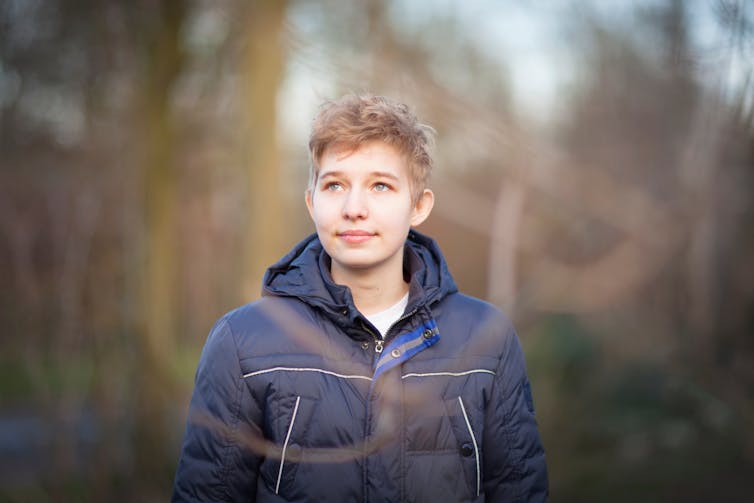
Triggered by hormonal changes in the brain and body, puberty marks a physical transformation. Oestrogen and testosterone – often called “sex hormones” – drive many familiar changes, such as breast development and periods or a deeper voice and facial hair.
For most young people, the pubertal changes they experience align with their gender. However, for trans and gender diverse adolescents, these changes can be distressing and may lead to a sense of disconnection from their true sense of self.
(We’ll use the term “trans” in this article to refer to transgender and gender diverse people.)
Why do young trans people use sex hormones?
To support trans adolescents, oestrogen and testosterone may be used to induce physical changes that better align with their gender.
Oestrogen stimulates breast development, alters body fat distribution, results in softer skin, and reduces facial and body hair, creating a more feminine appearance.
Testosterone deepens the voice, increases facial and body hair, promotes muscle growth and stops periods, creating a more masculine appearance.
Hormones are just one means by which people can affirm their gender and only some trans adolescents seek sex hormone treatment. Other means include puberty suppression, changing your name, pronouns, hair, clothing and legal documents.
When do trans people start sex hormones?
Many trans people start taking sex hormones as adults.
For those who start as adolescents, hormones are introduced when a young person is considered to have the intellectual and emotional maturity to make this decision.
The starting age also varies depending on the person’s preferences, family support and barriers to accessing care. These barriers include long wait times, regional disparities, costs, legal or policy restrictions, and challenges navigating the health system, all of which make it harder to get timely, reliable care.
Before starting hormone therapy, trans adolescents undergo comprehensive assessment and counselling with a team of mental health professionals and medical doctors who specialise in transgender health. This helps ensure young people understand the potential benefits, limitations, risks, and long-term implications of treatment.
This process involves their family and is designed to provide time, support and space for shared, informed decision-making.

Treatment with sex hormones usually begins with low doses, after which adjustments are made over time under regular clinical monitoring.
Subsequent physical changes occur gradually over several years, as is true for puberty, and some of these are irreversible. Breast growth or a deepened voice, for example, will persist if treatment is stopped.
What are the benefits?
The largest study to date followed 315 trans and gender diverse adolescents for two years after starting oestrogen or testosterone. It found a significant increase in how comfortable participants felt about their appearance. This was accompanied by significant improvements in life satisfaction and reductions in depression and anxiety.
More recently, Australian youth mental health research centre Orygen conducted a review of the overall evidence. It reported sex hormone treatment for young trans people is associated with body image satisfaction and reduced psychological symptoms, including depression, anxiety and suicide attempts, thoughts and/or planning.
An independent review of the evidence commissioned by NSW Health reported similar conclusions and found sex hormone therapy was associated with reduced gender dysphoria, which is the distress experienced when a person’s gender identity differs from their sex reported at birth.
Together, these published outcomes are consistent with decades of clinical and lived experience that young trans people report feeling more at ease in their bodies, more confident in social settings, and more optimistic about their future after starting hormones.
What about unwanted effects?
Like all medical treatments, sex hormone therapy involves the potential for unwanted effects.
Oestrogen, for example, can increase the risk of blood clots and breast cancer in the long-term, but the overall risk appears low.
Testosterone can increase acne as well as the number of red blood cells the body produces. Too many red cells can make a person’s blood too thick and increase the likelihood of a stroke or heart attack. Monitoring red cell counts and adjusting the dose of testosterone helps reduce these risks.
Oestrogen and testosterone can also affect the reproductive system. Oestrogen can stop sperm production and testosterone can stop the ovaries from releasing eggs, but neither treatment should be considered an effective form of contraception.
Given the possibility that trans adolescents might wish to stay on hormone treatment long-term, they are usually offered fertility counselling before starting treatment. The option to freeze sperm or eggs exists, although access and affordability can be a challenge.
One unwanted effect that has received a lot of attention relates to regret. There is fear adolescents who start hormone treatment will regret this decision later on.
At this stage, the risk of regret among adolescents starting hormone therapy appears low. Harvard researchers recently followed a cohort of 1,050 adolescents who had received hormone therapy, and only one was noted to have expressed regret.
However, the risk of regret is inherent to any medical treatment. Allowing adolescents the dignity of risk to make their own decisions respects their autonomy.
Sex hormones have been used in trans adolescents since at least the 1980s, and so far the evidence suggests these treatments are safe and work well for those who receive them. Nonetheless, long-term research into their safety (and effectiveness) is ongoing and essential.
What about consent?
Past decisions of the Family Court of Australia established a requirement for both parents to provide consent for their trans adolescent to access hormonal treatments, treating this care as legally exceptional.
However, a 2022 decision of the Queensland Supreme Court ruled an adolescent, who is under the age of 18 and has sufficient understanding and intelligence to consent for themselves, could consent to their own hormone treatment.
Despite this, some gender clinics still require consent from both parents. If there’s a dispute between parents, the matter should be taken to court, to reach a resolution based on the adolescent’s best interests.
Testosterone and oestrogen therapy are not new or experimental. They are grounded in decades of clinical practice and growing evidence. What is new is the public attention. We need to ensure policies and conversations are based on facts, not fear.
Cristyn Davies reports voluntarily being co-chair of the Human Rights Council of Australia; co-chair of the Child and Youth Special Interest Group for the Public Health Association of Australia; President of the Australian Association For Adolescent Health; an ambassador to Twenty10 Incorporating the Gay and Lesbian Counselling Service of New South Wales; and co-chair of the research committee for the Australian Professional Association for Trans Health.
Blake Cavve is a senior research officer at The Kids Research Institute Australia and an adjunct researcher at The University of Western Australia, with ongoing research collaborations with the Child and Adolescent Health Service. Blake has recieved funding from the Perth Children's Hospital Foundation and the Raine Medical Research Foundation. He is a member of the Australian Professional Association for Trans Health, and the World Professional Association for Transgender Health.
Ken Pang is a Senior Principal Research Fellow at the Murdoch Children's Research Insititute and a paediatrician at the Royal Children's Hospital in Melbourne. He receives research funding from the Australian National Health and Medical Research Council and the Medical Research Future Fund. He is a member of the Australian Professional Association for Trans Health, the World Professional Association for Transgender Health, and the editorial board of the journal, Transgender Health.
Michele O'Connell is paediatric endocrinologist at the Royal Children's Hospital in Melbourne. She is a co-investigator on research studies funded by the Medical Research Future Fund and a member of the Australian Professional Association for Trans Health.
Rachel Skinner receives funding from the National Health and Medical Research Council's Medical Research Future Fund and the Australian Research Council for related research. She is an adolescent medicine paediatrician employed by the Sydney Children's Hospitals Network and provides clinical care to trans young people. She has professional memberships with the Royal Australasian College of Physicians, the Australian Association of Adolescent Health, the Society of Adolescent Health and Medicine, the Australian Professional Association of Transgender Health and the World Professional Association of Transgender Health.
This article was originally published on The Conversation. Read the original article.







